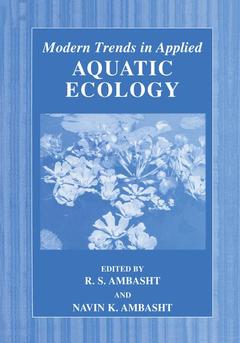Description
Modern Trends in Applied Aquatic Ecology, Softcover reprint of the original 1st ed. 2003
Coordinators: Ambasht R.S., Ambasht Navin K.
Language: English
Subject for Modern Trends in Applied Aquatic Ecology:
Keywords
Biomonitoring; Ecology; algae; ecosystem; ecosystems; environment; hydrology; wetland
Modern Trends in Applied Aquatic Ecology
Publication date: 09-2012
379 p. · 17.8x25.4 cm · Paperback
Publication date: 09-2012
379 p. · 17.8x25.4 cm · Paperback
Modern trends in applied aquatic ecology
Publication date: 12-2002
384 p. · Hardback
Publication date: 12-2002
384 p. · Hardback
Description
/li>Contents
/li>
Organisms and environment have evolved through modifying each other over millions of years. Humans appeared very late in this evolutionary time scale. With their superior brain attributes, humans emerged as the most dominating influence on the earth. Over the millennia, from simple hunter-food gatherers, humans developed the art of agriculture, domestication of animals, identification of medicinal plants, devising hunting and fishing techniques, house building, and making clothes. All these have been for better adjustment, growth, and survival in otherwise harsh and hostile surroundings and climate cycles of winter and summer, and dry and wet seasons. So humankind started experimenting and acting on ecological lines much before the art of reading, writing, or arithmetic had developed. Application of ecological knowledge led to development of agriculture, animal husbandry, medicines, fisheries, and so on. Modem ecology is a relatively young science and, unfortunately, there are so few books on applied ecology. The purpose of ecology is to discover the principles that govern relationships among plants, animals, microbes, and their total living and nonliving environmental components. Ecology, however, had remained mainly rooted in botany and zoology. It did not permeate hard sciences, engineering, or industrial technologies leading to widespread environmental degradation, pollution, and frequent episodes leading to mass deaths and diseases.
1. Bioassessment of Health of Aquatic Systems by the Use of Diatoms.- 2. The Management of Wetlands for Biological Diversity: Four Principles.- 3. Use of Plants in Monitoring Heavy Metals in Freshwaters.- 4. Hydrochemical Determinism, Ecological Polymorphism, and Indicator Values of Aquatic Bryophytes for Water Quality.- 5. Plant Succession in Littoral Habitats: Observations, Explanations, and Empirical Evidence.- 6. Phycoremediation: Algae as Tools for Remediation of Mine-Void Wetlands.- 7. UV-B Impact on the Life of Aquatic Plants.- 8. The Significance of Ultraviolet Radiation for Aquatic Animals.- 9. Stress Responses in Cyanobacteria.- 10. Biomonitoring and Bioindicators in Aquatic Ecosystems.- 11. The Ecology of Wetlands Created in Mining-Affected Landscapes.- 12. Conservation of Soil and Nutrients through Plant Cover on Wetland Margins.- 13. Identification, Assessment and Mitigation of Environmental Impacts of Dam Projects.
© 2024 LAVOISIER S.A.S.
These books may interest you

Southwood's Ecological Methods 126.47 €



